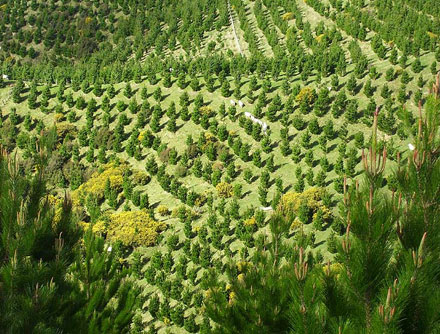
A scientific breakthrough could replenish vast expanses of our countryside with lush native forest – and offer a lucrative new forestry industry for New Zealand. Source: NZ Herald, Jamie Morton
Scion researchers have discovered how to grow native trees, including rimu and totara, from cuttings taken from parent trees instead of seeds, enabling them to grow much faster and in larger amounts.
The new technology will be used a multi-million dollar nursery site opening near the Bay of Plenty village of Minginui this weekend, in a partnership with local iwi Ngati Whare.
While Rotorua-based Scion has been working with indigenous species for more than 50 years, it’s only been recently that scientists have narrowed down the specific approach of taking cuttings.
Scion research and investments general manager Dr Russell Burton said the propagation of podocarps in general had always been challenging, and attempting to steer the natural process using cuttings only presented more hurdles.
But the advantages of being able to do it were huge.
“It overcomes many of the current problems encountered such as the difficulty in sourcing viable seed, since many species have irregular seed-crops with mast-years at seven year intervals.”
In mast years, more seed than usual was produced by the trees, but in other years, indigenous seed could be very scarce or difficult to source.
Even once the seed had been sourced, it germinated unevenly or, often, not at all.
Cuttings, however, mirrored the parent tree’s attributes.
Three years ago, when Scion was in the final stages of proving the viability of the research, Ngati Whare approached the organisation wishing to establish a new nursery at Minginui.
Their aim was to sell indigenous plants initially for the restoration of the ancient Whirinaki Forest as parcels of lands became freed up from pine plantations, and then to supply the riparian planting market.
“Scion’s research was at a stage where a partner was required to help scale up the technology commercially,” Burton said.
Together, the iwi and Scion sourced seed from the Whirinaki Forest, one of finest examples of mature podocarp forests left in the country.
The forest has large mature podocarps, some of which are more than 800 years old and quite possibly the tallest of those species in New Zealand.
“In general, the Whirinaki forest consists of trees with superior growth and form properties which are essential if we are produce the best possible plant stock from which cuttings can be taken and new forests developed.”
What the approach could mean for New Zealand’s natural landscapes was promising.
Increasing native forests – something recently urged by a major Pure Advantage study – offered strong environmental benefits, such as protecting land and waterways from erosion, and sheltering native wildlife.
“We should also not ignore the commercial potential of planted native forests and the ability for these to create high-value products and jobs in our regions,” Burton said.
“This will require a new model for forestry where conservation and commercial activities work together – jobs, resilient forests, forest biodiversity, more forests, and regional economic growth.”
“We see native trees as complementing our current exotic forests with each species providing timbers with highly valued properties in different markets.”
Burton said it had been “inspirational” to work alongside Ngati Whare.
“Their passion for indigenous trees and indigenous forestry, their commitment to seeing the landscape cloaked in trees that have their origins from Whirinaki has been a driving force behind turning a clever piece of science and technology into a reality.”
An overgrown piece of land with some derelict buildings has been completely cleared and restored to create a state-of-the-art nursery for the cultivation of podocarp seedlings.
“It’s taken a huge effort by everyone, especially to clear the land and renovate the former forestry buildings that make up the nursery … but we have done it and it is already providing dividends to the whanau,” Ngati Whare spokesperson Bronco Carson said.
“Our whanau are already benefiting through employment and training and that will only grow as the nursery gets up to speed.”
Carson was also excited about what the development could mean for future generations.
“You know, many of us have lived by the Whirinaki Forest for so many years we take it for granted. It’s always been there.
“But now the significance of what we have and the fact that we have Kiatiakitanga, or guardianship, emphasises our values and the relationship that we have traditionally had with the forest.”
The local kura (school) would be involved with the nursery and Ngati Whare’s mokopuna would learn about growing plants, high level science and what it meant to regenerate a native forest, he said.
“They will also learn about the iwi’s history of sustainable milling, how that changed with the arrival of pinus radiata plantations and what happened when the Forestry Service was corporatised and mills closed.
“They will learn about our people’s history and how, through initiatives like the native nursery, that they will be part of a productive and prosperous future for Ngati Whare.”





